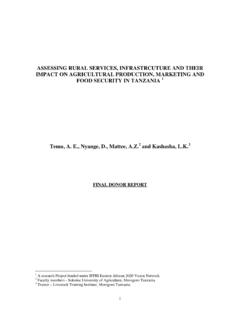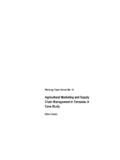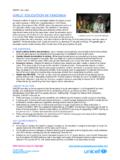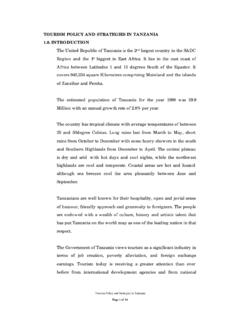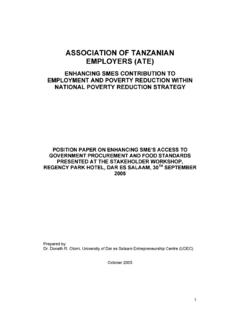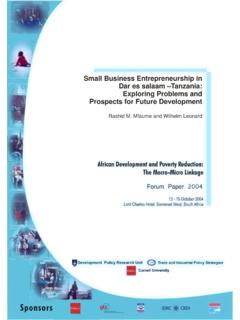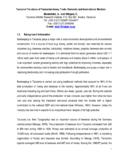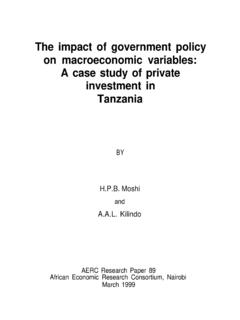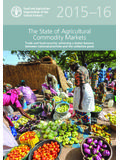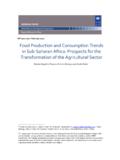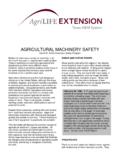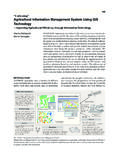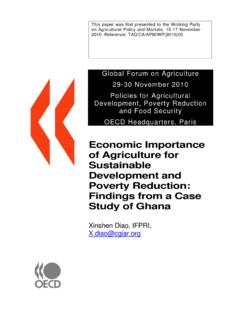Transcription of MAJOR AGRICULTURAL EXTENSION PROVIDERS …
1 22-4/1 4:29 PM 155. African Study Monographs, 22(4): 155-173, December 2001 155. MAJOR AGRICULTURAL EXTENSION PROVIDERS IN. tanzania . Deogratias F. RUTATORA. Centre for Sustainable Rural Development, Sokoine University of Agriculture Amon Z. MATTEE. Centre for Sustainable Rural Development, Sokoine University of Agriculture ABSTRACT While AGRICULTURAL EXTENSION services in tanzania have mostly been provided and financed by the public sector, the landscape is changing with regard to the provision of EXTENSION services in the country. Observations reveal that several non-governmental organi- sations (NGOs) and farmer-led initiatives have, over time, supplemented EXTENSION service delivery of the public EXTENSION services with cost-sharing, but these experiences have not been formally integrated into the EXTENSION system nor has their potential to reduce public expenditure and improve quality of EXTENSION service been considered.
2 As the government continues to face financial difficulties, it has started to reconsider the issue of public exten- sion service and is currently entertaining the possibilities of gradually divesting the public sector of EXTENSION , leaving the private sector and users to take an increasing responsibility. This paper brings to light MAJOR PROVIDERS of EXTENSION services in tanzania to help inform decision-makers on how various actors can support AGRICULTURAL EXTENSION on a sustainable basis. Key Words: Public EXTENSION service; AGRICULTURAL EXTENSION PROVIDERS ; Cost effectiveness;. Private EXTENSION service; tanzania . INTRODUCTION. AGRICULTURAL EXTENSION in tanzania , besides being a core function of the govern- ment, has been and still remains almost entirely financed by the public sector. Over the years, there has been too much government dominance in the management of the sector with declining resources, while coordination with the private sector, church- based organizations, and other Non-Governmental Organizations (NGOs) has often been very minimal.
3 Observations reveal that several NGO and farmer-led initiatives have, over time, supplemented EXTENSION delivery of the public EXTENSION service with cost-sharing, but these experiences have neither been formally integrated into the EXTENSION system nor has their potential to reduce public expenditure and improve quality of EXTENSION service been considered (Ministry of Agriculture and Cooperatives, 2000). As the government continues to face severe financial difficul- ties, funds are curtailed for support services to agriculture, including EXTENSION . Under these circumstances, the government has started to reconsider the issue of public EXTENSION service and is currently deliberating on pluralism in EXTENSION ser- vices delivery and the possibilities of gradually divesting the public sector of exten- sion, thus leaving the private sector and users to take on an increasing responsibility.
4 22-4/1 4:29 PM 156. 156 RUTATORA & MATTEE. Of late, the Ministry of Agriculture and Cooperatives (MAC), has been restruc- tured in order to create a small manageable organization, which is more efficient and responsive to farmers' problems and needs. In parallel, the Government at large has been undergoing MAJOR reforms under which its role would be limited to the core functions of governance, the commercial activities would be passed on to the private sector, the roles and functions of Ministries would be rationalized and consequently the civil service downsized. The regional government has been restructured and trimmed down, with the district focus enhanced by transferring resources from the national and regional levels to the districts and making district administration com- munity-based. The thrust is to have the EXTENSION services well-nested at the lowest level of government.
5 Under the Regional Administration Act, 1997 and the Local Government Act No. 6 of 1999, the responsibility for implementing EXTENSION ser- vices lies with the local government authorities. In view of the above, the landscape is changing with regard to the provision of EXTENSION services in the country in terms of key actors, approaches and manage- ment styles of EXTENSION services. At the same time, it is becoming increasingly evi- dent that the EXTENSION services are being more and more dependent on donor funds, be it through the Ministry or NGOs (most of whom depend on external sources of funds). In a drive to increase smallholder productivity, the government with the assis- tance of the World Bank and the International Fund for AGRICULTURAL Development (IFAD) launched two projects, namely the National AGRICULTURAL and Livestock EXTENSION Rehabilitation Project (NALERP) in June, 1989 and the Southern Highlands EXTENSION and Rural Financial Services Project (SHERFSP) in 1991, respectively.
6 Besides NALERP achieving its goal of increasing AGRICULTURAL output given the number of farmers covered by the EXTENSION staff, at the time of termina- tion of NALERP in May 1996, it was apparent that AGRICULTURAL EXTENSION was more supply-driven than demand-driven and that issues of relevance, cost-effectiveness, ownership and sustainability were not adequately addressed. As a follow-up to NALERP, the National AGRICULTURAL EXTENSION Project Phase II (NAEP II), a World Bank-funded project, was launched in October 1996 to continue to improve the delivery of EXTENSION services to smallholder farmers for increasing their incomes and productivity, while improving its relevance, cost-effectiveness and sustainabil- ity. In addition, the project is expected to initiate a process of private sector /NGO/farmer participation in AGRICULTURAL EXTENSION including selective privatisa- tion, where feasible, and enhanced research ( EXTENSION )-farmer linkages.
7 This paper, which is based on a countrywide study (Mattee & Rutatora, 2000), describes MAJOR PROVIDERS of EXTENSION services in tanzania , including their organi- zational structure, methodology, coordination, funding, effectiveness and sustain- ability. While assessing the performance of past and current AGRICULTURAL EXTENSION PROVIDERS in the country, reference was made to the 1997 report, Sustainability of AGRICULTURAL EXTENSION Services in tanzania (Bureau of AGRICULTURAL Consultancy and Advisory Services, 1997), the current consultancy study by Isinika (2000) and a report by the National Task Force on AGRICULTURAL EXTENSION Reform (MAC, 2000). 22-4/1 4:29 PM 157. MAJOR AGRICULTURAL EXTENSION PROVIDERS in tanzania 157. PAST AND CURRENT AGRICULTURAL EXTENSION PROVIDERS SINCE. 1988. Prior to 1988, during the two MAJOR periods, namely, the post-independence (1961-1966) and the post-Arusha Declaration (1967 to the mid 1980's), efforts were aimed at transforming peasant agriculture to large-scale and improved AGRICULTURAL production, respectively.
8 While the post-independence period was characterized by liberalization of markets for AGRICULTURAL produce, the unique feature of the post- Arusha Declaration was the state control of MAJOR means of production. During the two periods, the government was a MAJOR provider of almost all MAJOR services, including EXTENSION under the rubric of public services. It should be noted that dur- ing the post- Arusha Declaration period, neither the private sector nor civil society was encouraged to offer such kind of services. Since the mid-1980's, however, the public sector has been withdrawing from direct production and provision of goods and services as well as reliance on centra- lized control and state ownership of the MAJOR means of production. This shift is reflected in increased private sector and NGO participation in the production, pro- cessing and marketing of AGRICULTURAL inputs and produce.
9 Since 1988 to date, the MAJOR EXTENSION PROVIDERS (Appendix 1) can be identified as follows: 1. Ministry of Agriculture and Cooperatives 2. Local government authorities under the Ministry of Regional Administration and Local Government 3. Non-governmental organizations 4. Donor-supported projects 5. Private agribusiness 6. Community-based organizations (CBOs, farmer's groups, associations, cooperatives, societies and networks). Categories (1) and (2) above can be classified as public EXTENSION services, while categories (3), (5), and (6) fall under private EXTENSION . Category (4) remains in between as they involve both the public and private EXTENSION services. I. Public EXTENSION Service 1. The Ministry of Agriculture and Cooperatives As mentioned above, most of the AGRICULTURAL EXTENSION services in tanzania almost for the entire period since independence were provided by the government, through MAC.
10 During that period ( before decentralization of EXTENSION services to local authorities), MAC had the mandate for the provision of EXTENSION services to the whole country. Organizational structure For a period between 1988 to 1999 before the new MAC organizational structure became effective, the responsibility for AGRICULTURAL EXTENSION services was under the Commissioner for Agriculture and Livestock Development (CALD), who was assisted by the Assistant Commissioner for EXTENSION Services (ACES). The World 22-4/1 4:29 PM 158. 158 RUTATORA & MATTEE. Bank-supported project, namely, the National AGRICULTURAL and Livestock EXTENSION Rehabilitation Project (NALERP) launched in phases in sixteen regions of tanzania mainland since 1989 initiated the organisational structure in place during the period between 1988 and 1999. For each of the 16 regions and their respective districts, the EXTENSION services were the responsibility of the regional and district EXTENSION officers, respectively, being supported by subject matter specialists.
